Sound long-term strategic planning is indispensable for the successful delivery of infrastructure projects. It requires alignment with a country’s development aims and economic conditions across sectors. Weak or insufficient planning disrupts infrastructure delivery, impeding resource optimisation, co-ordination, implementation and operation. To design a clear and coherent long-term strategic plan, it is helpful to align it with other policy objectives, undertake needs assessment, link it with budget allocations and sources of funding, and ensure robust co-ordination mechanisms across sectors and levels of government.
Infrastructure governance
High-quality infrastructure is one of the backbones for achieving long-term inclusive development. nevertheless, infrastructure projects can sometimes fail to meet their time frame, budget and service delivery objectives. this is often due to shortcomings in the country’s governance framework for infrastructure. Good governance of infrastructure not only promotes value for money and affordability, but also helps to make the right projects happen in a manner that is trusted by users and citizens.

Key messages
In achieving specific policy goals, selecting projects among the many identified investment possibilities presents countries with a major challenge. Embedding evidence-based project selection and prioritisation processes in government decision-making ensures value for money, affordability for the public budget and users, and minimal sustainability risks. These methodologies are indispensable to improve the investment decision-making process to ensure accountability, clarity and transparency.
Threats to integrity often stifle infrastructure projects. Integrity risks can arise at every step of the project and result in higher economic and social costs. Corruption, disinformation and citizens’ disengagement can result in poor targeting of infrastructure investments and negatively impact trust and shared ownership of infrastructure planning and delivery. Good governance of decision-making processes, including systematic stakeholder participation and transparency, is indispensable for ensuring the efficient use of resources. Moreover, procurement processes for infrastructure should be open, neutral, competitive and transparent.
Context
Infrastructure Governance to support the implementation of G20 Principles for Quality Infrastructure Investment
Infrastructure governance can be understood as the policies, frameworks, norms, processes and tools used by public bodies to plan, make decisions, implement and monitor the entire life cycle of public infrastructure. Governance has a key role to play in delivering well-articulated and whole-of-government infrastructure responses and ensuring infrastructure projects are well-targeted. While there has been an increasing focus on infrastructure governance in recent years, the crisis has sharpened the need to accelerate reform efforts in this area.

Different strategies and tools have been used to promote alignment of strategic long-term infrastructure visions with environmental policy objectives.
69% of the surveyed countries invest in key projects enabling the implementation of broader sustainability initiatives (e.g. circular economy systems, sustainable mobility, net-zero carbon emissions, climate change mitigation and adaptation), 59% focus on identifying cross-sector synergies to reduce negative environmental impacts, and 56% on adapting existing infrastructure to improve environmental performance. Fewer have adopted resource efficiency targets in the construction and operation of infrastructure (41%) or research and development to promote environmentally friendly infrastructure (34%).

Toolkit
-
The OECD Infrastructure Toolkit is an online resource to guide policymakers in the planning, financing and delivery of infrastructure. The Toolkit takes a modal approach, addressing various areas of infrastructure. Initially, the governance of infrastructure is featured with other domains expected to be added over time.Learn more
Related publications
-
 18 July 2023
18 July 2023
Related events
Related policy issues
-
Infrastructure assets, such as transportation networks, utilities and social infrastructures that deliver public services, are complex and long-term. They require financial structures and commitments from governments, developers, financial intermediaries and stakeholders that understand short-term and long-terms risks and can provide stability to the infrastructure development and viability over time. Ensuring financing and investment can be made from the private sector in addition to public sources is essential for countries to meet infrastructure needs for the economic and social wellbeing of society and communities.Learn more
-
Water and sanitation, transport, energy and other infrastructure underpin human development, economic growth and poverty alleviation. The OECD provides data, analysis and guidance to policy makers as they strive to mobilise the necessary finance; design and implement efficient, cost-effective and sustainable projects; and control for their environmental and social impacts.Learn more
-
Governments have responsibility for managing a range of complex crises. Such crises include pandemic, climate risk, other natural hazard, cyber or terrorist attacks. The COVID-19 crisis illustrates the transboundary nature of such critical risks. Effective crisis management coordinates with the private and voluntary sectors. The OECD fosters mutual learning amongst governments to collect data and notable practices on strategic crisis management and increasing national resilience in the face of an uncertain future.Learn more
-
Sustainable and resilient infrastructure is designed and built to withstand and recover from disasters and disruptions, such as extreme weather events or socioeconomic challenges. It is built to contribute to long-term sustainability goals while incorporating measures to enhance resilience to shocks and stresses. As infrastructure assets are being planned and developed, maintained and upgraded, it is critical that these objectives are taken into account. Ensuring financing is available and costs towards these considerations are made, will ensure that infrastructure assets are being adapted to the economic and social environment in which they operate.Learn more





